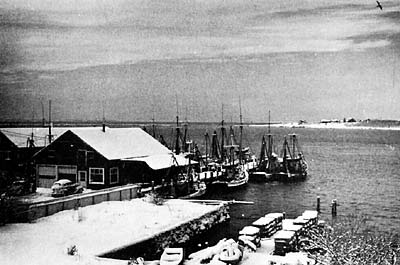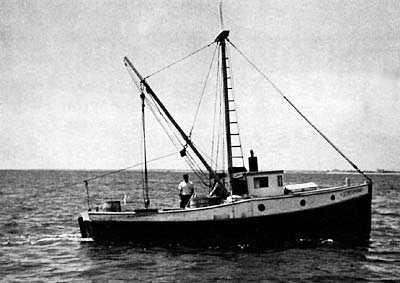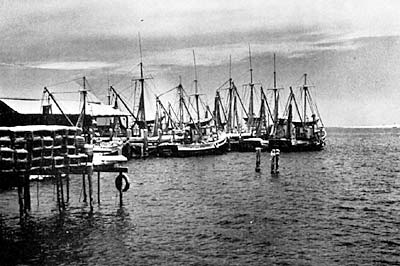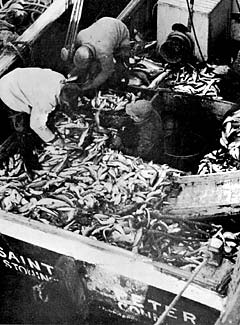CAPTAIN "ST. PETER" From "Des Islas" to Stonington:
The Story of Manuel Madeira and His Wife "Connie"
(Part Two)
By Mary Madeira
(From Historical Footnotes, November 1973)
This story is continued from our last number. For those who may not have read the previous installment we will say that it was a series of episodes from the lives of Manuel Madeira of Stonington and his wife"Connie."
Manuel came to Stonington from Vila Franca do Campo on the island of San Miguel in the Azores in 1902, and Connie Costa, accompanied by her parents in 1904. They were married on January 1, 1905 and their lives were spent in the Borough of Stonington.
The author, Mary Madeira, is the wife of Manuel's brother Joe and the sister of Connie. Her story resumes at about the time of World War I.

"World War I was at its critical stage, and many good paying jobs were available for defense work. Joe got one in a nearby shipyard.
In the early spring of 1918, I received a letter from the landlord, a notice to vacate. A ship-construction company had bought the entire waterfront where we lived. A large house, containing four apartments, was to be built there.
After Manuel got home from fishing, and had finished a hearty meal, Connie gave Manuel the mail which contained his fish returns and the notice to move, and said to Manuel, "Oh, dear God, where on earth are we going to find a tenement for nine people and another one on the way and convenient for fishing too?"
Two months later Joe and I and our baby daughter moved to School Street, Stonington.
Manuel searched high and low with no luck. He was well known and had good credit so he decided to seek advice from Mr. Broughton, Real Estate Agent and the Town Sheriff. In a short while, with the agent's help, Manuel was able to borrow two hundred dollars as a down payment and bought a large two-tenement house, on an easy payment plan, at 9 Omega Street. Another son Lawrence was born in June, and in July they moved to their permanent home."
THE FIRST WORLD WAR FLU EPIDEMIC
"The influenza that broke out and killed millions of people throughout the world, struck Stonington in September 1918. Young and old were stricken. The dead were taken immediately for burial to combat the spreading of infection. Joe and I came down and our baby daughter died. She was taken one hour later from us for burial.
Manuel and his seven children were all sick and put to bed. Mother, Connie, and baby Lawrence did not catch it. Connie, masked, nursed the others. Dr. Taylor made morning and night calls. Manuel developed bronchial pneumonia and was treated with hot mustard and onion poultices on his chest and back, both night and day.
Fortunately; with the help of God, Connie and mother fought this dreadful disease and were able to nurse the sick and keep up their daily tasks throughout the whole ordeal with no bad effects. Within the next month the children had recovered and were back in school. Manuel, after three weeks in bed, was up and around but with poor resistance which lasted for months, and was unable to return to work."
ARMISTICE DAY
"November 11, 1918. The war was over. Mill and factory workers, school kids, fishermen, mothers pushing baby carriages, all took part in parading in the streets in a joyous celebration. Bands gathered and played marches. Many people watched from their windows, crying for their loved ones they had recently buried from the flu.
In the year that followed, Manuel was much plagued by illness. He was subject to bronchial coughs and pleurisy which kept him in bed for weeks during the winter months but by mid-spring he was able to resume his lobstering.
Many of the same hardships continued until Manuel's three oldest sons were old enough to work. During the winter months the boys fished, which helped to make ends meet.
Since the boat Manuel owned was rather small and the boys enjoyed fishing with their father, they decided to build a larger boat for dragging."*
*This was the St. Peter. She was built at the Franklin Post Yard in Mystic.

THE LIFE OF A FISHERMAN'S FAMILY
"The alarm clock was set at 4 a.m. as always. Manuel would get up to watch the weather. He would start coffee and call the boys. When they were ready he would serve the coffee and then shortly they left. Connie had prepared the basket of lunch the night before. On busy days she would be up at 4 a.m. with the others. There was the bread to be baked, the boiler had to be put on the stove for washing clothes, and six children to get ready for school. Then of course there was the daily cooking to feed her family of thirteen. The oldest daughter Mary worked at the Velvet Mill.
Mother would do the mending and patching and taking care of the fire. The hardest job of all was taking over for Connie during the confinements of childbirth and sickness.
A strong wind would often drive the ST. PETER and her crew back to shore with a poor catch. Somehow, Connie would manage to have either a clam chowder or beef stew and always the fresh, hot corn meal bread (Manuel's favorite) waiting for them.
Three years later Connie, carrying her fifteenth child, developed a kidney ailment while in her seventh month of pregnancy. She was the first patient to ride in the first Stonington ambulance to the Lawrence Memorial Hospital in New London, Connecticut, where she gave birth, by a Caesarean section, to a premature baby girl, but died February 20, 1926 at the age of forty. The baby died the following day and Connie was laid to rest with her baby at her side. The following Wednesday the funeral took place during a deep blizzard.
Connie's death meant the loss of a great champion, who had fought bravely through the crises of life and death that plagued her husband and family. She was a guardian angel to the children she so dearly loved.
In grief and sadness, mother and the two oldest daughters, Mary and Rosella, went about their daily tasks, sacrificing much to keep the family together in the belief that this would be what Connie would want most. Her dear soul was in heaven.
Within the year Manuel married a widow, with a seven year old son named Anthony. The three oldest boys, Manuel, Jr., Joseph, and Tony went on their own and married, but remained as a crew fishing with their father. Shortly after, the daughters left, leaving the youngest, Agnes, six years old and the remaining four boys, Frank, Lawrence, John, and Alfred at home."
MACKEREL FISHING
"With the prospect of a good mackerel season in sight, Manuel decided to buy a seine. It was seventy-five fathoms long and cost him five hundred dollars. This kind of fishing required extra work, and an extra hand was hired for setting and hauling. Manuel hired his brother, Joe. Joe didn't need an alarm clock with his brother's prompt rapping on the window at 4 a.m. every morning to get him up. I would get up too, in order to make fresh coffee and to have his lunch ready before he left.
The men fished between Watch Hill, Block Island, and Montauk Point. The net was set at the first sight of mackerel. They averaged a load of seventy to eighty barrels, depending on the number of hauls in a day and the capacity of ST. PETER, and would dock in the afternoon. Many times, ST. PETER and the other boats which were mackerel fishing had to wait for more barrels. The fish were sent to market by rail.
One morning Joe came home unusually early and in a happy mood. Not expecting him I said, "What's the matter, Joe, breakdown?"
"Oh, no," he said. "We didn't break down, but we almost sank with a load of mackerel from the first haul. We got short of barrels. While we are waiting how about fixing me something to eat?"
A quick meal of fried linguica, homemade bread and bottle of beer, fixed him up and he left once again for the dock.
When he came back, late that afternoon, he told me that they had shipped eighty-three barrels of mackerel which had brought a good price.
Manuel and his crew of four fished for mackerel for three seasons and prospered. Then he once again returned to dragging and mending nets."

A SAD EVENT
"In the early Spring of 1948 Manuel's boat, ST. PETER, had engine trouble and was towed for repairs up the Mystic River to the Lathrop Engine Company, in Mystic.
Meanwhile, Albert, now 21, and Alfred were fishing with their brother Joe on his boat, CONNIE M., until ST. PETER was ready for fishing.
It was one week before Easter Sunday, around noon, on the choppy Block Island grounds. The men were setting the net, when one of the ropes from the net got caught on the stern bitt. Albert went to pull the rope clear, but was caught in the line and pulled overboard.
Alfred put the boat in neutral when he saw his brother go over. When he sighted him he stripped off his boots and plunged into the sea, but lost sight of his brother and finally came aboard again. Albert was missing. Joe signaled the other boats that were fishing in the area, and they all took part in a search for Albert. For one week the fleet dragged and searched but Albert's body was never recovered.
This tragedy greatly affected Manuel and his wife.
Joe was so shaken from this sad experience he tied up the CONNIE M. until he was able to regain his strength and courage and the whole family was deeply saddened."
"The remainder of this story covers the final twenty-eight years of Manuel's life.
Five children were born to Manuel and his second wife Mary; Albert (the first son), Lena and Arthur (a set of twins), Edmund who died during infancy, and Saltina.
During the first five years Manuel and his sons had tough fishing, in all kinds of rough and foggy weather. When Alfred and Albert reached working age, the older brothers had boats built of their own and left their father, leaving Alfred, Albert and Frank to take over and fish with their father.

Manuel, in failing health, kept working and pinched to save all he could for his old age.
The next spring, ST. PETER was back at its home port and ready for fishing. With the warm weather in sight, Manuel with his will of iron attempted, once again, to fish with his two sons, Alfred and Frank.
They fished through the summer months, up until in the late fall, but Manuel was stricken again with his bronchial ailment and was laid-up for the winter.
At last, he reached the point where he could no longer cope with fishing, and Alfred and his brother-in-law, Charlie, took over the ST. PETER."
A TRIP ABROAD
"Manuel longed to make a trip back home to visit his elderly mother of ninety-four whom he hadn't seen in forty-seven years, and his sister Lucy who was born after Manuel had come to America.
It was late fall of 1949. Manuel flew by Pan American to the Azores. There he was greeted by his brother and sister, Antone and Gloria. They had already been notified and were waiting for Manuel at the Santa Maria Airport. They went by boat to Vila Franca.
On arrival, Manuel was greeted by a large group. He was embraced by his dear mother, who by this time had poor eyesight. Lucy cried with joy upon seeing her brother for the first time. A joyous reunion took place and lasted throughout Manuel's stay.
During his stay Manuel had the pleasure of giving away his niece in matrimony. Pictures were taken of the family at the wedding.
The remaining months of his life were spent in and out of bed in a serious condition. A television set amused him during the day. His family would come and bring him homemade foods. His fishermen friends visited him often and together they would reminisce about the old happy days and the good old ST. PETER. These were the times that helped to brighten Manuel's life. A shot of brandy was always at hand to serve to his friends and together they spent many cheerful evenings. Finally he was forced to leave his home and was taken in by his daughters, Lena and Saltina, who lived together. They were very kind to their father. The doctor would make daily calls. His children were at his bedside when the end came. He died on May 9, 1954 at the age of sixty-nine.
Funeral services took place from his home on Omega Street. The large crowd at the church and cemetery proved that the memory of Honest, Courageous, Capt. Manuel Jacinto Madeira would remain alive forever.
Manuel was buried at Connie's side in St. Mary's Cemetery, Stonington, Connecticut.